By Milan Perera, News Reporter
Bristol historian Dr Richard Stone delivers public lecture on the city's dark legacies of slavery.
'The Bricks of Bristol are baked in the blood of slaves' wrote one chronicler during the reign of Queen Anne in 1714, and yet there are no immediately recognisable sites in Bristol which have direct links to Transatlantic Slave Trade from which the city benefitted. There is a two-fold danger in this: the historically unsound memorialisation and the provision of ammunition for those who bypass Bristol’s Slave Trade links.
The public lecture titled “Slavery Obscured, Slavery Revealed: Remembering Histories of Enslavement in Bristol” by the esteemed University of Bristol academic Dr. Richard Stone could not have come at a better time, shedding some light on these hitherto overlooked aspects of Bristol’s past.
Dr. Stone’s academic expertise lies with the history and legacies of the Atlantic Slave Economy. A sizeable proportion of his research is focused on Bristol’s own involvement in the Transatlantic Slave Trade. Over the years, with his meticulous and painstaking work in this area, he managed to unweave a complex web of slave-trade economy, along with its abolition, philanthropy, and the material prosperity of the city.

According to Dr.Stone we do not need to travel too far to see the legacies of slavery, as the crest of the University of Bristol itself is crowded with references to colonialism and slave trade. “The most offending symbol on the university crest is actually not the ship. Probably that’s the least offensive symbol. The dolphin is a reference to the Colston Research Society (Founded 1899, named after Slave Trader)”
Dr. Stone acknowledged the irony was not lost on him that a lecture on “Slavery Obscured” was held at the Wills Memorial Building, named after the eponymous business magnate who, along with Fry family, was once the biggest benefactor of the university since its founding in 1909. Though neither family had direct links to slave trade both enormously profiteered from the frameworks laid out during the period the period.
Some would challenge the notion that University of Bristol has benefitted from the legacies of slavery purely on the grounds that slavery was abolished in the 19th century, well before the university was founded in 1909. Dr.Stone was quick to point out that, although the abolition of slavery took place in 1833, exploitative practices such as indentured servitude were still carried out in most places. For example, ‘as late as 1909, the Fry family were sourcing a lot of their cocoa beans from São Tomé and ‘indentured servants’ were bought from the coast of Nigeria and shipped to São Tomé.'

More often than not historical events are linked to places with tangible remnants of the events which trigger poignant associations with past. As far as Bristol’s links to the Transatlantic Slave Trade is concerned, there are no historically verifiable sites associated with slavery, which has led to apathy and neglect. Slavery was easily forgotten and memorialisation has focused itself on mythologised and contested sites, such as Whiteladies Road and Black Boy Hill. Evidence suggests that Whiteladies Road was named after a female religious order who wore white habits, while Black Boy Hill was named after Charles II who was known for his raven hair.
There is strong imperative to recognise Bristol’s slave trade links and produce an unvarnished account of them for future generations. For instance, Pero’s Bridge near the Promenade is dedicated to the memory of Pero, an Caribbean man who arrived in Bristol in 1783 and was enslaved by the Pinney family.
It was interesting to note that the apotheosis of Edward Colston only began in 1721, nearly 200 years after his death. Panegyric accounts of his philanthropy were added to the city annals and his legacy was celebrated every year on Colston Day, when prayers were said in his memory. Dr.Stone pointed out that not everyone was convinced of the selective generosity of Colston, since as early as 1920 some were casting serious doubts on his mythologised history. He referred to Rev. H.J Wilkins, a local historian who wrote what should have been a groundbreaking expose of Colston in 1920, but was largely drowned out by the zeal with which the trader was venerated.
I spoke to @Dr_RGStone about the dark history of the Wills and Fry families and how they shaped Bristol.
— آسيا (@AssiahHamed) January 10, 2022
The links between philanthropy, Bristol University and transatlantic slavery run deep, as discovered in Dr. Stone's research. https://t.co/EQN3H6qZGD
Unveiling plaques does not redress historic injustices, but demands of descendants of enslaved people must be met. Speaking exclusively to Epigram, Dr. Stone pointed out:
‘The key things institutions need to do are to be honest, to listen, and to act. Doing something to redress the legacies of historic enslavement is crucial in allowing society to come to terms with this difficult past. But it is not for the descendants of the enslavers to dictate what these solutions should be, they need to listen to the descendants of the enslaved and what they need to deliver equality”
When asked about the need to shed some light on Bristol’s obscured slave trade legacies, Dr. Stone stressed that ‘One of the problems with remembering slavery and its legacies in Bristol is that the city simply doesn’t look like slavery. There are no rows of chains, or rotting hulks of ships; instead we just see grand buildings. It is thus essential for historians and others to talk about this past so that it can no longer be forgotten and obscured.’
Finally, the question was put to Dr.Stone of what the University of Bristol is currently doing to address its connections to slavery. He stated that ‘It’s been a long journey for the University investigating its links to slavery, and we still have a long way to go. Professor Otele and others have already made great progress in investigating the myriad ways the University has benefitted from enslaved labour, and it is really important that we follow this through to its conclusions. Crucially, though, the next step has to be to act to redress this legacy, as apology means nothing without action. And we need a thorough process of consultation to work out the best form for these actions to take.’









